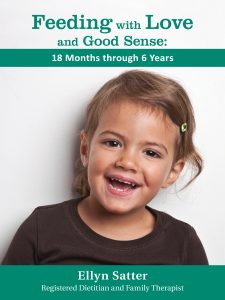

Family Meals Focus
The Ellyn Satter Institute Newsletter
Children Who are Obsessed with Food
by Ellyn Satter, MS, MSSW, Dietitian and Family Therapist
For a PDF of this issue of Family Meals Focus, click here
Consider the infant described by his parents as, from birth, “a fast eater, eats a lot, wants to eat all the time.” Consider the preschooler who “moans when she eats and plans her next meal before finishing this one” or the one who is “obsessed with food—always clearing his plate and pestering for more food, especially when he is upset or anxious.” The theory of behavioral susceptibility to obesity, originated at University College, London, claimed parent ratings on their Children’s Eating Behavior Questionnaire (CEBQ), which captures these parent descriptions, to predict child obesity. Those predictions were made without assessing the parent-child feeding relationship.1
For the record, obesity is not my word. I only use it when sources do.
From a clinical perspective, behavioral susceptibility to obesity is an iatrogenic condition: It is caused by diagnosis and treatment. Moreover, the theory is groundless when taken in the context of the feeding relationship. Provided they are fed with routine and trust, even children who particularly enjoy food and eat relatively large amounts regulate their intake and grow in the way that is right for them. Routine and trust translate into the Satter Division of Responsibility in Feeding (sDOR): Parents do the what, when, and where of feeding, children do the how much and whether of eating.2
The behavioral susceptibility theory is a self-fulfilling prophecy. Predicting a child’s obesity frightens parents into feeding restrictively, whereupon children become preoccupied with food and eat as much as they can when they get the chance. Uninterrupted, this parent-child feeding dynamic becomes a vicious cycle with the parent becoming more and more restrictive and the child more and more food-preoccupied. The child’s weight accelerates, not because the child enjoys eating, but because they are afraid of going hungry.
Editors and peer reviewers accept studies based on the behavioral susceptibility theory despite the consistent and serious methodological flaw of failing to assess parent-child feeding dynamics. The National Institutes of Health funds many of the conventional studies on child susceptibility to overeating and obesity. In their zeal to address child “overweight/obesity,” are researchers, editors, reviewers, and funders forgetting to act on behalf of children?
Before the increase in understanding of feeding dynamics in the last one or two decades, those oversights were understandable. However, now that sDOR.2.6y has been validated,3 measuring parent-child feeding dynamics is readily accessible. Child-eating-problem focused instruments that give indications of restrictive feeding, pressure to eat, and parent monitoring have been available for decades.4, 5 Given the availability of these no-cost instruments, there is no excuse for researchers to continue to ignore feeding dynamics and scare parents with predictions based on flawed research.
Conventional thinking: “There is something the matter with the child”
Nonetheless, poorly designed research continues and is publicized, and parents and practitioners need to be able to responsibly ignore it.
Consider a review from Britain of over 1000 studies correlated child BMI with children’s enthusiastic eating, preoccupation with food, poorly defined stopping place, and eating for emotional reasons.6 None of the over one thousand studies assessed parent-child feeding dynamics.
Although it did not take feeding dynamics into account, a Pennsylvania State University study concluded that one-year-olds whose parents gave high scores on CEBQ tended to become fatter and eat more as eight-year-olds.7
A joint British-Dutch study predicted adolescent eating disorders based on children’s “abnormality:” enjoying and being enthusiastic eaters.8 A later publication by the same group acknowledged that the real problem, rather than children’s enthusiastic eating, was parental pressure to eat, restriction, and instrumental feeding: feeding for emotional reasons.9 The first article got a lot of media attention. The second article, not so much. The media loves fearmongering.
Saying children’s eating enthusiasm is obesogenic is the same as saying that blonde children or those with freckles will get too fat.
The trust-based wisdom: It’s about the parent-child feeding relationship
There is ample research to support trusting feeding with enthusiastically eating children.
British researchers correlated children’s “avid” eating with arbitrary, unreliable, and interfering feeding: Parents provided structured meals but allowed ad libitum eating between times, fed for emotional reasons, and considered whether or not the child was hungry before they let them eat.10 The children were afraid of going hungry and reacted accordingly.
Parent restriction at home, not the child’s weight per se, correlated with children’s eating more in the research laboratory when offered large portion sizes of high-calorie food.11 The same held true for girls given after-lunch access to high-calorie food. Irrespective of their weight, restricted girls ate more; Girls who had not been restricted did not.12
Despite predictions to the contrary, twin studies showed children only ate for emotional reasons when parents feed for emotional upsets.13 Mood-induction studies show all children snack when they are bored; children restricted at home eat more.14
It’s not about children’s eating attitudes and behaviors, per se; It’s about parental acceptance. Eating competent parents—those who regularly and comfortably let themselves eat as much as they wanted of food they enjoyed—referred to their children as ‘‘good eaters.’’ On the other hand, non-EC parents frequently described their child’s eating negatively.15 Parents who scored high on sDOR.2-6y—who followed sDOR—accepted their child’s eating eccentricities. Parents who scored low on sDOR.2-6y did not accept their children’s level of food enjoyment and normal food fussiness.16
It’s all about the feeding relationship
Which brings us to the point: Even when they eat a lot and/or love to eat, children who are given routine with feeding and trust with eating—when parents follow sDOR—children eat as much as they need and grow in the way that is right for them.
On the other hand, when parents lose trust in their child to know whether and how much to eat, they become restrictive with feeding. Frightened children lose their ability to regulate their food intake and become obsessed with food. Unless food restriction is reversed, it becomes a serious problem that can and does dysregulate weight.
What to do about “food obsession?”
Act as an advocate for parents: Help them to see the theory of behavioral susceptibility to obesity for the invalid destructiveness and interference that it is. Support parents in trusting their child’s eating so they can follow sDOR.
Do secondary intervention by getting to the bottom of the child’s preoccupation with food. Help parents see feeding from the child’s point of view by finding out what is undermining the children’s ability to regulate their food intake. Children are “food obsessed” because they are afraid of going hungry. Explain how the child’s fear disrupts their eating and weight. Then help parents establish sDOR, be scrupulous about maintaining structure, and be trusting with respect to letting the child eat as much as they want at structured, sit-down meals and snacks. Include high-fat, high-sugar “forbidden” food on a regular basis so it loses its “special” aura, and the child can be as matter-of-fact about eating it as any other food.
At first the child’s “food obsession” will become more pronounced. However, their eating will moderate as parents continue to accurately follow sDOR, including extinguishing their tendencies to be restrictive or otherwise controlling with feeding. The child begins to trust parents to let them eat as much as they are hungry for and have food they enjoy at structured meals and snacks. After that, the child can regain sensitivity to their internal cues of hunger and fullness and eat the same as any other child of the same age and stage of development: sometimes a lot, other times not so much.
To support parents in following sDOR, consider recommending one of the Feeding with Love and Good Sense booklets. First chapters are free for the asking; All booklets are available in pdf.
References
- Carnell S, Wardle J. Appetite and adiposity in children: evidence for a behavioral susceptibility theory of obesity. Am J Clin Nutr. 2008;88:22-29.
- Satter E. The Satter Feeding Dynamics Model (fdSatter) and the Satter Division of Responsibility in Feeding (sDOR): A narrative review. TBD. 2022;
- Lohse B, Mitchell DC. Valid and reliable measure of adherence to Satter Division of Responsibility in Feeding. J Nutr Educ Behav. 2021:211-222.
- Birch LL, Fisher JO, Grimm-Thomas K, et al. Confirmatory factor analysis of the child feeding questionnaire: a measure of parental attitudes, beliefs and practices about child feeding and obesity proneness. Appetite. 2001;36:201-210Stone RA, Haycraft E, Blissett J, et al. Preschool-aged children’s food approach tendencies interact with food parenting practices and maternal emotional eating to predict children’s emotional eating in a cross-sectional analysis. J Acad Nutr Diet. 2022. doi:10.1016/j.jand.2022.02.001
- Musher-Eizenman DR, Holub SC, Hauser JC, et al. The relationship between parents’ anti-fat attitudes and restrictive feeding. Obesity (Silver Spring). 2007;15:2095-2102.
- Kininmonth A, Smith A, Carnell S, et al. The association between childhood adiposity and appetite assessed using the Child Eating Behavior Questionnaire and Baby Eating Behavior Questionnaire: A systematic review and meta-analysis. Obes Rev. 2021;22:e13169. doi:10.1111/obr.13169
- Keller KL, Pearce AL, Fuchs B, et al. PACE: a novel eating behavior phenotype to assess risk for obesity in middle childhood. J Nutr. 2024. doi:10.1016/j.tjnut.2024.05.019
- Derks IPM, Nas Z, Harris HA, et al. Early childhood appetitive traits and eating disorder symptoms in adolescence: a 10-year longitudinal follow-up study in the Netherlands and the UK. Lancet Child Adolesc Health. 2024;
- Harris HA, Kininmonth AR, Nas Z, et al. Prospective associations between early childhood parental feeding practices and eating disorder symptoms and disordered eating behaviors in adolescence. Int J Eat Disord. 2024/03/01 2024;57:716-726.
- Edwards KL, Blissett J, Croker H, et al. Examining parents’ experiences and challenges of feeding preschool children with avid eating behaviour. Appetite. 2024/07/01/ 2024;198:107372.
- Kling SM, Roe LS, Keller KL, et al. Double trouble: Portion size and energy density combine to increase preschool children’s lunch intake. Physiol Behav. 2016. doi:10.1016/j.physbeh.2016.02.019
- Birch LL, Fisher JO, Davison KK. Learning to overeat: maternal use of restrictive feeding practices promotes girls’ eating in the absence of hunger. Am J Clin Nutr. 2003;78:215-220.
- Herle M, Fildes A, Llewellyn CH. Emotional eating is learned not inherited in children, regardless of obesity risk. Pediatr Obes. 2018;13:628-631.
- Stone RA, Blissett J, Haycraft E, et al. Emotional eating following a laboratory mood induction: The interaction between parental feeding practices and child temperament. Food Qual Prefer. 2023;112:105008. parental feeding practices and child temperament. Food Qual Prefer. 2023;112:105008. doi:https://doi.org/10.1016/j.foodqual.2023.105008 Accessed 2023/12/01/.
- Lohse B, Satter E, Arnold K. Development of a tool to assess adherence to a model of the division of responsibility in feeding young children: using response mapping to capacitate validation measures. Child Obes. 2014;10:153-168.
- Ruder EH, Lohse B. The sDOR.2-6y Is a valid measure of nutrition risk independent of bmi-for-age z-score and household food security status in preschool aged-children. Nutrients. 2024;16.
Explore
Feeding with Love and Good Sense: 18 months through 6 years

